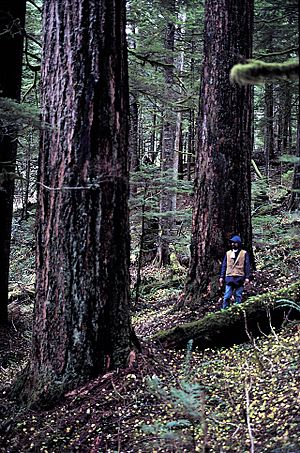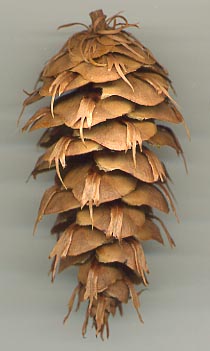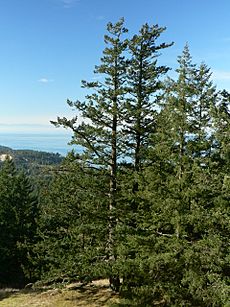Coast Douglas-fir facts for kids
Quick facts for kids Coast Douglas-fir |
|
|---|---|
 |
|
| An old forest of Coast Douglas-fir trees in Oregon. | |
| Scientific classification |
|
| Kingdom: | Plantae |
| Clade: | Tracheophytes |
| Division: | Pinophyta |
| Class: | Pinopsida |
| Order: | Pinales |
| Family: | Pinaceae |
| Genus: | Pseudotsuga |
| Species: | |
| Varietas: |
P. m. var. menziesii
|
| Trinomial name | |
| Pseudotsuga menziesii var. menziesii |
|
The Coast Douglas-fir (scientific name: Pseudotsuga menziesii var. menziesii) is a very tall evergreen tree. It is also known as Pacific Douglas-fir, Oregon pine, or Douglas spruce. These trees grow naturally in western North America. You can find them from west-central British Columbia, Canada, all the way south to central California, United States.
In Oregon and Washington, Coast Douglas-firs grow from the Cascades mountains to the Pacific Ocean. In California, they are found in the Klamath and California Coast Ranges. They grow from sea level near the coast up to about 1,800 meters (5,900 feet) high in the California Mountains. Further inland, you'll find a different type of Douglas-fir called the Rocky Mountain Douglas-fir.
Contents
Discover the Coast Douglas-fir Tree
The Coast Douglas-fir is one of the tallest trees in the world! It is the second-tallest conifer (cone-bearing tree) after the coast redwood. It's also the third-tallest tree overall, after the coast redwood and the Eucalyptus regnans.
How Tall Do Douglas-firs Grow?
Today, it's common to see Coast Douglas-fir trees that are 60 to 75 meters (200 to 250 feet) tall. Their trunks can be 1.5 to 2 meters (5 to 6.5 feet) wide. Some have even been recorded at amazing heights of 100 to 120 meters (330 to 390 feet) and widths of 4.5 to 5.5 meters (15 to 18 feet)!
The tallest living Coast Douglas-fir is called the Doerner Fir. It stands 99.76 meters (327.3 feet) tall in Oregon. The widest one is the Queets Fir in Washington, with a trunk 4.85 meters (15.9 feet) across. These trees can live for more than 500 years, and some even live over 1,000 years!
What Does a Douglas-fir Look Like?
Young Douglas-fir trees have thin, smooth, gray bark with many resin blisters. As they get older, their bark becomes thick and corky. Their new shoots are brown or olive-green, turning gray-brown over time.
The buds are shaped like narrow cones, about 4 to 8 millimeters (0.16 to 0.31 inches) long. The leaves are like needles, about 2 to 3.5 centimeters (0.79 to 1.38 inches) long. They are green on top and have two whitish lines underneath. If you crush the leaves of a Coast Douglas-fir, they have a sweet, fruity, resin-like smell.
The mature female seed cones hang down from the branches. They are 5 to 8 centimeters (2 to 3 inches) long and 2 to 3 centimeters (0.79 to 1.18 inches) wide when closed. They open up to about 4 centimeters (1.6 inches) wide. These cones grow in spring, are green at first, and turn orange-brown in autumn. Each cone holds about 25 to 50 seeds. The seeds are small, about 5 to 6 millimeters (0.20 to 0.24 inches) long, with a wing that helps them fly in the wind.
In a forest, old Douglas-fir trees usually have a narrow, tall crown. Their lower branches often fall off, leaving a clear trunk. It can take 70 to 80 years for the trunk to be clear of branches up to 5 meters (16 feet) high.
Douglas-firs start making seeds when they are 20 to 30 years old. They don't produce a lot of seeds every year. Over 5 to 7 years, they usually have one big seed crop, a few small or medium ones, and one year with no seeds.
Douglas-fir's Role in Nature
The roots of Coast Douglas-fir trees are not super deep. They often grow close to the surface of the soil. However, if the ground is drier, the tree can grow deeper roots.
Old, dead Douglas-fir trees, called snags, are very important in the forest. They provide homes for many birds that nest in tree cavities. Mature Douglas-fir forests are the main home for the red tree vole and the spotted owl. Red tree voles build their nests in the Douglas-fir's leaves, high up in the tree, and mainly eat Douglas-fir needles.
Douglas-fir seedlings are not a favorite food for black-tailed deer or elk. But these animals might eat them in winter when other foods are scarce. Blue grouse often eat Douglas-fir needles in the spring. In winter, New World porcupines like to eat the inner bark of young Douglas-fir trees.
The seeds of Douglas-fir are a very important food source for small animals. Mice, voles, shrews, and chipmunks eat a lot of these seeds. The Douglas squirrel collects and hides many Douglas-fir cones to eat later. They also eat pollen cones, inner bark, and young needles. Many birds also rely on these seeds, including dark-eyed juncos, song sparrows, golden-crowned sparrows, white-crowned sparrows, pine siskins, purple finches, and the Douglas-fir red crossbill. The red crossbill is specially built to get seeds from Douglas-fir cones.
Where Douglas-firs Grow Best
The Coast Douglas-fir is the most common tree west of the Cascade Mountains in the Pacific Northwest. It grows well in almost all forest types and on different kinds of soil. It loves the moist, mild climate there and grows bigger and faster than the Rocky Mountain Douglas-fir.
Many other trees grow alongside the Coast Douglas-fir. These include western hemlock, Sitka spruce, sugar pine, western white pine, Ponderosa pine, grand fir, coast redwood, western redcedar, California incense-cedar, Lawson's cypress, tanoak, and bigleaf maple. Sometimes, you can find whole forests made up only of Douglas-fir trees.
Many Shrubs also grow with Douglas-firs. In the northern areas, you might see vine maple, salal, Pacific rhododendron, Oregon-grape, red huckleberry, and salmonberry. In drier, southern areas, common shrubs include California hazel, oceanspray, creeping snowberry, western poison-oak, ceanothus, and manzanita. In wet coastal forests, old Douglas-fir trees are often covered in mosses and lichens.
How Douglas-firs Change the Forest
Douglas-fir trees don't like deep shade. This plays a big part in how forests grow and change over time in the Pacific Northwest. In old forests, you'll find many young western hemlock and western redcedar trees growing under the shade of bigger trees. But you won't find many young Douglas-firs there. This is because Douglas-firs need a lot of sunlight to grow.
When a large tree in a mature forest dies, it creates an opening in the canopy. This lets sunlight reach the forest floor. The western hemlock and western redcedar seedlings, which can handle shade, already have a head start. They quickly grow to fill the gap. Over hundreds of years, western hemlock and western redcedar will become the main trees in the forest canopy.
Douglas-fir trees are known as a "pioneer" species in the wet forests of British Columbia, Washington, Oregon, and California. This means they need a big event, like a forest fire or a large landslide, to clear the forest and expose bare soil. Their seedlings prefer to grow in these open, sunny spots. Douglas-firs also grow faster than most other trees. This gives them an advantage, allowing them to grow taller than slower-growing species when a new forest starts.
The age of Douglas-fir trees can tell us when the last big fire happened in a forest. Because Douglas-firs live a long time, they can stay the main tree in a forest for over 300 years after a fire. Douglas-firs are also very good at surviving fires. Once they are about 100 years old, their bark becomes thick enough to protect them from heat. Large Douglas-firs often survive low-intensity forest fires.
Douglas-firs and Logging
Logging practices over the last 200 years have created new open areas where Douglas-firs can grow well. Because Douglas-fir wood is very useful and the trees grow quickly, they are a popular choice for timber companies. These companies often replant clear-cut areas with Douglas-fir seedlings. The sunny conditions in clear-cut areas also naturally help Douglas-firs grow.
Because of clear-cut logging, most forests west of the Cascade Range are now dominated by Douglas-fir. Trees like western hemlock and western redcedar, which would normally be more common in old forests, are less common now. In some drier areas of California, where Douglas-fir used to be a minor tree, it has become more common. This is because people have stopped natural fires, which used to keep Douglas-firs from taking over oak woodlands.
Uses of Douglas-fir Wood
Coast Douglas-fir is one of the best trees in the world for producing timber. It provides more wood than any other tree in North America. Its wood is used for many things, like building lumber, large timbers, and plywood. It's also used for railroad ties, mine supports, house logs, posts, flooring, and furniture.
Douglas-fir is also used a lot in landscaping. People plant it as a single beautiful tree or in groups to create privacy screens. It's also a very popular Christmas tree.
Giants of the Forest: Largest Douglas-firs
As of 1995, the Coast Douglas-fir was the second-tallest conifer in the world, just after the coast redwood. There are many Coast Douglas-fir trees that are 60 to 75 meters (200 to 250 feet) tall and 1.5 to 2 meters (5 to 6.5 feet) wide in old forests. Some have even reached heights of 100 to 120 meters (330 to 390 feet) and widths of 4.5 to 5.5 meters (15 to 18 feet).
The tallest living Coast Douglas-fir is the "Doerner Fir" in Oregon, standing 99.76 meters (327.3 feet) tall. The widest is the "Queets Fir" in Washington, with a diameter of 4.85 meters (15.9 feet). The largest in terms of wood volume is the Red Creek Fir in British Columbia, Canada. Douglas-firs often live for more than 500 years, and some live over 1,000 years.
The tallest well-recorded conifer was a Coast Douglas-fir called the Mineral Tree in Washington. It was measured in 1924 and was 119.8 meters (393 feet) tall. Scientists believe Douglas-firs could potentially grow even taller, up to 130 to 145 meters (430 to 476 feet).
There are also old stories of even taller Douglas-firs.
- A tree cut down in British Columbia in 1902 was said to be 126.5 meters (415 feet) tall and 4.3 meters (14 feet 3 inches) wide.
- The Nooksack Giant, a Douglas-fir cut down in Washington in 1897, was reportedly 141.7 meters (465 feet) tall! It was also said to be 10.4 meters (34 feet) around its base and 67 meters (220 feet) to its first branch. This tree was estimated to be 480 years old.
The tallest tree in the United Kingdom is also a Coast Douglas-fir. It grows in Scotland and is 68.4 meters (224 feet) tall.





